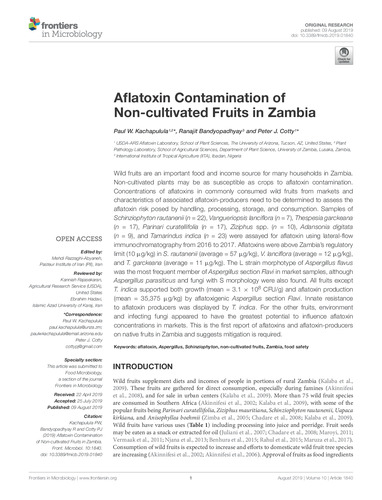Aflatoxin contamination of non-cultivated fruits in Zambia
Abstract
Wild fruits are an important food and income source for many households in Zambia. Non-cultivated plants may be as susceptible as crops to aflatoxin contamination. Concentrations of aflatoxins in commonly consumed wild fruits from markets and characteristics of associated aflatoxin-producers need to be determined to assess the aflatoxin risk posed by handling, processing, storage, and consumption. Samples of Schinziophyton rautanenii (n = 22), Vangueriopsis lanciflora (n = 7), Thespesia garckeana (n = 17), Parinari curatellifolia (n = 17), Ziziphus spp. (n = 10), Adansonia digitata (n = 9), and Tamarindus indica (n = 23) were assayed for aflatoxin using lateral-flow immunochromatography from 2016 to 2017. Aflatoxins were above Zambia’s regulatory limit (10 μg/kg) in S. rautanenii (average = 57 μg/kg), V. lanciflora (average = 12 μg/kg), and T. garckeana (average = 11 μg/kg). The L strain morphotype of Aspergillus flavus was the most frequent member of Aspergillus section Flavi in market samples, although Aspergillus parasiticus and fungi with S morphology were also found. All fruits except T. indica supported both growth (mean = 3.1 × 108 CFU/g) and aflatoxin production (mean = 35,375 μg/kg) by aflatoxigenic Aspergillus section Flavi. Innate resistance to aflatoxin producers was displayed by T. indica. For the other fruits, environment and infecting fungi appeared to have the greatest potential to influence aflatoxin concentrations in markets. This is the first report of aflatoxins and aflatoxin-producers on native fruits in Zambia and suggests mitigation is required.

